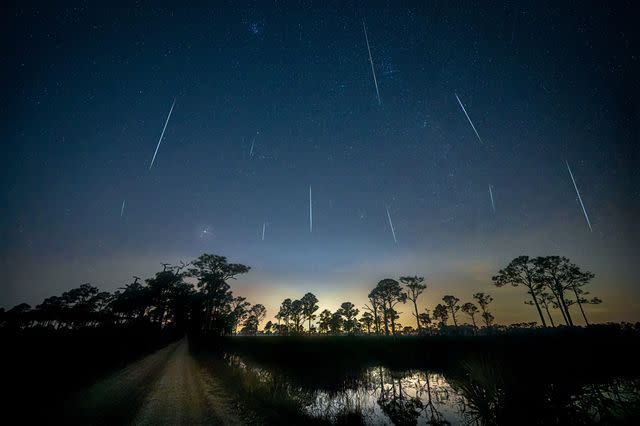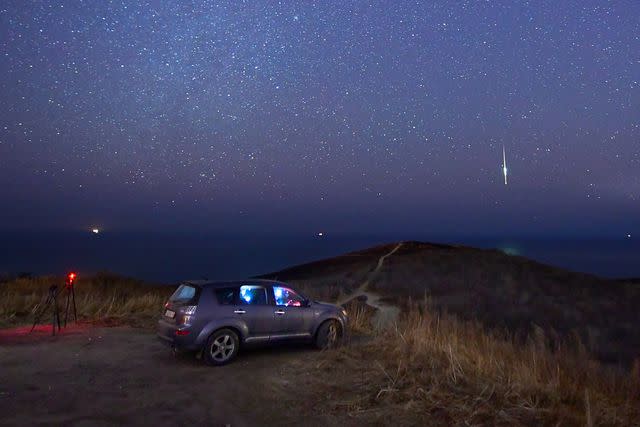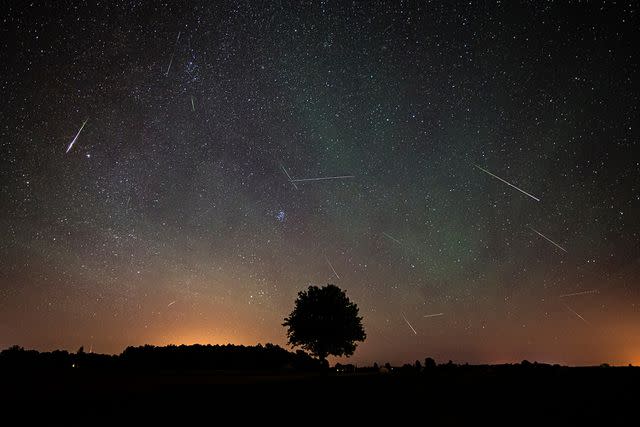All About the Geminid Meteor Shower, Including When It Peaks and How to Watch It
NASA considers the Geminids "one of the best and most reliable annual meteor showers," reaching approximately 120 shooting stars at its peak

It's a bird! It's a plane! No, it's another meteor shower!
The Geminids mark the last meteor shower of 2023, becoming active late November and peaking mid-December each year.
While spotting a shooting star is rare, NASA considers this celestial spectacle "one of the best and most reliable annual meteor showers." However, the space agency notes that wasn't always the case.
When the first Geminids were spotted in the mid-1800, roughly 10 to 20 meteors were seen per hour. Since then, the Geminids have increased tremendously; they can reach approximately 120 meteor showers per hour under perfect conditions.
And fortunately for star seekers, chances of spotting a meteor this year are looking bright! The sky will be dark thanks to the moon's young waxing crescent phase at the shower's peak, becoming full towards the end of the month on Dec. 26.
Here's your guide to the Geminid meteor shower, including when they peak and how to watch them.
Related: Leonid Meteor Shower 2023: When It Peaks and How to Watch It
When does the Geminid meteor shower peak?

The Gemind meteor shower became active on Sunday, Nov. 26 and will continue to shoot through Sunday, Dec. 24 on Christmas Eve. This year, the Geminids are expected to peak on Thursday, Dec. 14, 2023.
How to view the Geminid meteor shower?

Fortunately for stargazers, expensive space technology or equipment is unncessary for Geminid watching. Simply, all you have to do is look up at the night sky for a chance at spotting a shooting star!
Still, there are a few tips that can help make the process a little bit easier. For starters, situate yourself outside and away from all light pollution, like street lamps or illuminated signs.
While finding a dark location is preferred, there's not much us Earthlings can due to combat the glaring waning gibbous moon — so instead of spotting 100 to 150 meteors per hour, viewers in the Northern Hemisphere are more likely to catch 30 to 40 instead.
But remember, the Geminids are known for brightness, so skywatchers are in for a good show regardless!
Related: All About November's New Moon and What It Means for Your Zodiac Sign
Where does the Geminid meteor shower appear in the sky?

Meteors are the product of leftover comet particles and bits from asteroids. When these objects come close to the sun, they leave a dusty trail in their wake. Every year, these particles collide with Earth's atmosphere as they pass through, then disintegrate to form colorful streaks in the sky.
While comets are the true point of origin for meteor showers, many tend to think derive from their "radiant," or the point in the sky from which the stars appear to shoot. For the Geminids, its radiant is the constellation Gemini, the "Twins."
So it's logical to start by looking towards Gemini, but that isn't the only location you should be casting your eyes. According to NASA's Bill Cooke, "meteors close to the radiant have very short trails and are easily missed, so observers should avoid looking at that constellation."
(Pro tip: Lie down on the ground, adjust your eyes to the dark sky and simply take its vastness in to better your chances at spotting a star!)
Related: Here's Which Thanksgiving Food You Align with, Based on Your Zodiac Sign
What meteor shower comes after the Geminids?

The next meteor shower to become active after the Geminids are the Ursids. They become active on Dec. 13, peak between Dec. 21 -22 and remain active until Dec. 24, 2023.
For more People news, make sure to sign up for our newsletter!
Read the original article on People.

